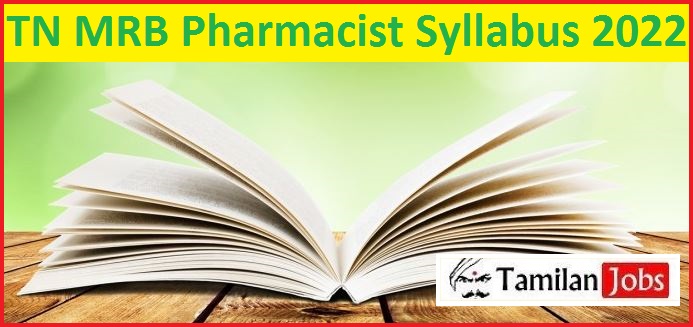TN MRB Pharmacist Syllabus 2022 Check Exam Pattern Here: The Tamil Nadu Medical Services Recruitment Board has released the TN MRB Pharmacist Post Recruitment 2022 for Various Vacancies. The candidates who are going to appear for the Tamil Nadu MRB Pharmacist post, those applicants can check out the TN MRB Pharmacist Exam Syllabus 2022 & TN MRB Pharmacist Exam Pattern 2022 here in this article. The applicants many of them in search of the TN Pharmacist Syllabus 2022 and Exam Pattern for the TN MRB Pharmacist. The candidates who are eligible to appear for the post of Tamil Nadu MRB Pharmacist can check this article to know more about the TN MRB Pharmacist Syllabus 2022 & Exam Pattern 2022.

TN MRB Pharmacist Syllabus 2022-Details
| TN MRB Pharmacist Syllabus 2022 & Exam Pattern Download | |
| Organization Name | Tamil Nadu Medical Services Recruitment Board (TN MRB) |
| Post Name | Pharmacist |
| Category | Syllabus |
| Selection Process |
|
| Job Location | Tamil Nadu |
| Official Site | mrb.tn.gov.in |
TN MRB Pharmacist Exam Pattern 2022
Tamil Nadu MRB has TN MRB Pharmacist Exam Pattern 2022 given below for the candidate’s sake
| Name of the Subject | Number of Marks | Time Duration |
| Tamil language Eligibility Test (SSLC Standard) |
50 | 1 Hour |
| Computer Based Examination (CBT) / Written Examination in Optical Mark Reader (OMR) – Sheet Objective Type Single Paper Exam for Pharmacist | 100 | 2 Hours |
| Total | 150 |
- There is no negative mark for the wrong answer.
- The question paper will be set in English Language Only
- Objective-type questions will ask on the Question Paper.
- The question will be on the standard of Diploma level in Pharmacy
TN MRB Pharmacist Exam Syllabus 2022
| Subject | Topics To be Covered |
| Pharmaceutics | Solid dosage forms, Liquid dosage forms, Semi-solid dosage forms, Dental and Cosmetic Preparation, Sterile Dosage Forms, Parenteral dosage forms, Ophthalmic Products, Prescriptions, Systems of weights and measures, Definition, theory, objectives, types, factors influencing, advantages & disadvantages, uses and equipment for the various processes: (a) Size reduction (b) Size Separation (c) Mixing and homogenization (d) Clarification and filtration (e) Extraction (f) Distillation (g) Drying (h) Sterilization (i) Aseptic techniques |
| Pharmaceutical Chemistry |
|
| Pharmacognosy |
|
| Pharmacology & Toxicology |
|
| Drug Store and Business Management |
|
| Hospital and Clinical Pharmacy |
|
| Pharmaceutical Jurisprudence |
|
| Biochemistry and Clinical Pathology |
|
| Health Education and Community Pharmacy |
|
| Human Anatomy and Physiology |
|
Tamil Nadu Medical Services Recruitment Board (TN MRB)